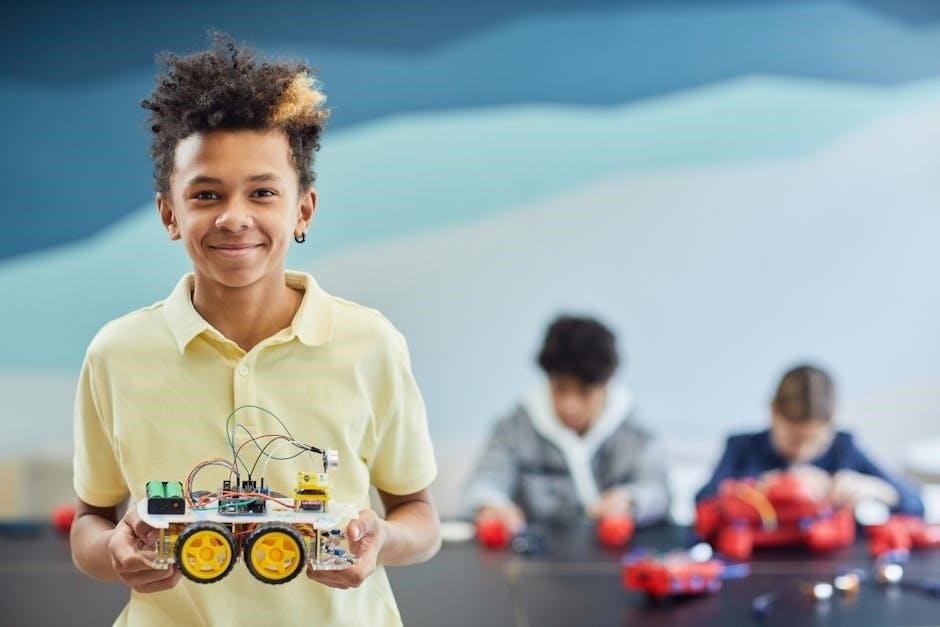
STEM activities for elementary students provide a foundation in science, technology, engineering, and math through hands-on, engaging experiences. These activities foster creativity, problem-solving, and critical thinking skills, preparing young learners for future challenges while making learning fun and interactive.
Why STEM Education Matters for Young Learners
STEM education is crucial for young learners as it fosters critical thinking, creativity, and problem-solving skills from an early age. By introducing science, technology, engineering, and math concepts in engaging ways, STEM activities help children develop a strong foundation for future academic success. These experiences also encourage collaboration and communication, preparing students to tackle real-world challenges. Early exposure to STEM sparks curiosity and builds confidence, making complex subjects more accessible. Moreover, STEM education equips students with skills essential for future careers, adapting to technological advancements, and addressing global issues. It creates a pathway for lifelong learning and innovation, shaping the next generation of thinkers and leaders.
Benefits of Hands-On STEM Activities in the Classroom
Hands-on STEM activities provide students with interactive learning experiences that enhance engagement and understanding. These activities make complex concepts tangible, allowing young learners to explore and experiment in a fun, iterative process. By encouraging trial and error, STEM exercises foster creativity, resilience, and problem-solving skills. Collaborative projects also promote teamwork and communication, essential for real-world applications. Immediate feedback through visible results helps students refine their ideas and learn from mistakes. This approach not only deepens their grasp of science, technology, engineering, and math but also builds confidence and curiosity. Hands-on learning prepares students to address challenges critically and innovatively, laying a strong foundation for future success.

Popular STEM Activities for Elementary Students

Popular STEM activities include building bridges with popsicle sticks, designing simple coding systems, and creating model structures. These hands-on tasks spark curiosity, creativity, and problem-solving skills in young learners.
Building Bridges with Popsicle Sticks and Push Pins
Building bridges with popsicle sticks and push pins is a classic STEM activity that challenges students to design and construct a sturdy structure. This hands-on project teaches fundamental engineering principles, such as tension, compression, and balance. Students work in teams to create a bridge using limited materials, fostering collaboration and problem-solving skills. The activity concludes with a test to determine which bridge can hold the most weight, encouraging critical thinking and creativity. This engaging exercise helps young learners understand real-world applications of engineering while developing teamwork and communication abilities. It’s an ideal way to introduce elementary students to the basics of structural design and stability.
Designing Simple Coding Systems for Problem Solving
Designing simple coding systems introduces elementary students to the basics of computer science and logical thinking. This activity encourages students to create a step-by-step guide, such as a map or sequence, to solve a problem. For example, they might design a code to navigate a maze or sort objects. By using visual cues and patterns, students develop problem-solving skills and understand how coding applies to real-world scenarios. This hands-on approach fosters creativity, critical thinking, and collaboration, making it an engaging way to introduce young learners to the fundamentals of technology and engineering. It also prepares them for more advanced coding concepts as they progress in STEM education.
Creating Model Structures for Real-World Challenges
Creating model structures engages elementary students in solving real-world problems using science, technology, engineering, and math. For example, students might design a bridge with popsicle sticks or build a shelter using everyday materials. These activities encourage critical thinking, teamwork, and creativity while teaching structural integrity and resource management. By simulating real-world scenarios, students develop problem-solving skills and learn to apply STEM concepts practically. This hands-on approach helps young learners visualize abstract ideas and understand how engineering and design can address everyday challenges, fostering a deeper appreciation for innovation and collaboration in STEM fields.

STEM Activities for the Classroom
Engaging STEM activities in the classroom promote hands-on learning, fostering creativity and teamwork. Simple materials like popsicle sticks and everyday items encourage students to explore STEM concepts practically.
Easy-to-Implement STEM Lessons for Teachers
Teachers can incorporate simple STEM lessons into their curriculum using everyday materials. Activities like bridge-building with popsicle sticks or designing coding systems are both effective and engaging; These exercises promote critical thinking and problem-solving skills without requiring advanced resources. Additionally, integrating STEM with other subjects enhances cross-curricular learning; Many free resources, such as lesson plans and activity sheets, are available online to help educators create meaningful STEM experiences. These tools ensure that students develop a strong foundation in science, technology, engineering, and math through fun and interactive learning opportunities.
Collaborative STEM Projects to Foster Teamwork
Collaborative STEM projects encourage students to work together, fostering teamwork and communication. Activities like group challenges, such as designing a bridge or solving a coding puzzle, promote shared problem-solving. These exercises teach students to rely on each other’s strengths and ideas, building confidence and interpersonal skills. By working in teams, young learners develop essential collaboration abilities while applying STEM concepts. Such projects also help students understand the value of diverse perspectives and constructive feedback, preparing them for real-world scenarios where teamwork is crucial. These engaging activities make learning fun while nurturing critical life skills.
Integrating STEM with Other Subjects for Cross-Curricular Learning
Integrating STEM with other subjects creates a holistic learning experience, showing how science, technology, engineering, and math connect to language arts, social studies, and the arts. For example, students can use math to design engineering projects or apply scientific concepts to solve historical problems. This approach fosters problem-solving, critical thinking, and creativity while reinforcing skills across disciplines. STEM activities like coding stories or designing eco-friendly buildings highlight how subjects interrelate. Such integration prepares students for a world where challenges require multidisciplinary solutions, breaking down subject silos and fostering a deeper understanding of how STEM impacts everyday life and other fields of study.

STEM Activities for Home Learning
Engage kids at home with fun, practical STEM activities using household materials. These exercises foster creativity, problem-solving, and learning through hands-on experiences in a familiar environment.
Fun and Practical STEM Ideas for Parents
Parents can easily incorporate STEM into daily routines with creative, low-cost activities. Build bridges with popsicle sticks, create simple coding systems using cards, or design marble runs. These hands-on projects encourage problem-solving and collaboration. Use household items like cardboard boxes, bottles, and magnets to spark curiosity. Activities like baking or gardening integrate math and science, teaching measurement and life cycles. DIY experiments, such as making slime or volcanoes, make learning fun. Encourage critical thinking through puzzles or building challenges. These engaging ideas help children develop essential STEM skills while fostering a love for learning in a supportive home environment.
Using Household Materials for STEM Experiments
Household materials offer endless possibilities for STEM experiments, making learning accessible and fun. Items like cardboard boxes, plastic bottles, tape, and magnets can be transformed into educational tools. For example, build bridges with popsicle sticks, create marble runs, or design simple machines; These activities encourage creativity and critical thinking while teaching fundamental STEM concepts. Parents and educators can use everyday objects to conduct experiments, such as making slime with glue and borax or creating volcanoes with baking soda and vinegar. These hands-on experiences help children develop problem-solving skills and foster a curiosity for science and engineering. Best of all, they are cost-effective and easy to set up at home or in the classroom.
Engaging STEM Games and Puzzles for Kids
Engaging STEM games and puzzles are powerful tools for developing critical thinking and problem-solving skills in children. Interactive games like coding robots, logic grids, and math-based board games make learning fun and challenging. Puzzles, such as building structures with magnetic tiles or solving pattern sequences, encourage creativity and spatial reasoning. These activities are designed to spark curiosity and prepare kids for real-world challenges. Many STEM games are available online or as apps, offering accessible learning opportunities for home or classroom use. By integrating play with education, these resources help children build a strong foundation in STEM subjects while fostering a lifelong love for learning.

Technology-Focused STEM Activities
Technology-focused STEM activities introduce elementary students to coding, robotics, and digital tools, fostering digital literacy and innovation. These activities prepare kids for a tech-driven future, enhancing problem-solving skills and creativity.
Coding is introduced to elementary students through simple, engaging activities that develop logical thinking and problem-solving skills. Platforms like ScratchJr and Code.org use visual blocks to teach programming basics. These tools allow young learners to create stories, games, and animations, making coding fun and accessible. Coding activities enhance digital literacy, foster creativity, and build foundational skills for future STEM careers. By solving puzzles and completing challenges, students learn sequencing, loops, and conditional statements. These experiences prepare them for more advanced programming concepts and instill confidence in using technology to solve real-world problems. Coding for kids is a gateway to innovation and critical thinking from an early age.
Using Digital Tools for STEM Learning
Digital tools enhance STEM learning by providing interactive and engaging experiences for elementary students. Platforms like tablets and educational apps offer access to videos, simulations, and hands-on activities that make complex concepts easy to understand. Tools such as the BBC Learning Hub provide lesson plans and resources to integrate STEM subjects seamlessly. Digital STEM tools foster collaboration, allowing students to work together on projects and share ideas. They also introduce real-world applications, sparking curiosity and preparing students for future careers. By leveraging technology, educators can create dynamic learning environments that cater to diverse learning styles and promote digital literacy from an early age.
Free STEM Apps for Kids
Free STEM apps for kids offer engaging ways to explore science, technology, engineering, and math. Apps like Toca Life: Hospital introduce medical science, while Duolingo ABCs teaches literacy and math basics. Khan Academy Kids provides interactive STEM lessons through games and activities. Socratic by Google helps students solve math and science problems using AI. These apps are designed to be fun and educational, making STEM accessible for young learners. They encourage critical thinking, problem-solving, and creativity while fostering a love for learning. Many apps are available for download on tablets and smartphones, making STEM education convenient and enjoyable for elementary students both in and out of the classroom.

Engineering and Design Challenges
Engineering and design challenges encourage creativity and problem-solving in young students. Activities like building bridges with popsicle sticks and creating model structures foster practical STEM skills.
Building Bridges and Testing Their Strength
Building bridges with materials like popsicle sticks and push pins is a classic STEM activity that challenges students to apply engineering principles. This hands-on project teaches structural integrity and problem-solving while fostering teamwork. Students design and construct bridges, testing their strength by adding weights. The activity encourages critical thinking and creativity, as they experiment with different designs to maximize durability. It also introduces basic concepts of tension, compression, and load distribution. This engaging challenge helps students understand how real-world engineering problems are solved, making it an excellent way to spark curiosity and interest in STEM fields. The activity aligns with broader educational goals of fostering innovation and practical learning.
Designing Innovative Solutions to Everyday Problems
Designing innovative solutions to everyday problems is a core STEM activity that encourages creativity and critical thinking in elementary students. By identifying real-world challenges, students brainstorm, prototype, and test their ideas using everyday materials like cardboard, fabric, and recycled items. This activity fosters collaboration and problem-solving skills, as students learn to refine their designs based on feedback and results. It also introduces key engineering concepts, such as functionality and efficiency. Through hands-on experimentation, students develop a mindset to approach problems methodically and think outside the box. This STEM-based approach not only enhances creativity but also prepares students to tackle complex challenges in the future; It makes learning interactive and meaningful, connecting STEM concepts to practical applications.
STEM Challenges for Elementary School Competitions
STEM challenges for elementary school competitions inspire students to apply their skills in science, technology, engineering, and math to solve complex problems. These challenges often involve designing and building models, such as bridges or robots, to meet specific criteria. Students learn to collaborate, think critically, and refine their ideas through trial and error. Competitions foster a spirit of friendly rivalry while promoting creativity and perseverance. Popular challenges include building the strongest bridge with limited materials or creating a simple coding system to solve a problem. Such activities prepare students for real-world engineering and design tasks while making STEM learning exciting and competitive. They also help students develop confidence and teamwork skills essential for future success.

Math and Problem-Solving STEM Activities
Math-based STEM projects integrate numerical concepts with real-world applications, fostering critical thinking and practical skills. Activities like measuring materials or solving puzzles make learning fun and engaging for students.
Math-Based STEM Projects for Elementary Students
Math-based STEM projects for elementary students combine numerical concepts with hands-on activities, making learning engaging and practical. Activities like measuring materials for bridge-building or calculating weights for structures help students apply math to real-world problems. These projects foster critical thinking and problem-solving skills, encouraging creativity and teamwork. By integrating math with science and engineering, students develop a strong foundation in numerical literacy and logical reasoning. Such projects make math accessible and fun, preparing young learners for future STEM challenges while building confidence in their mathematical abilities. These activities are designed to be interactive and educational, ensuring students enjoy the learning process while gaining essential skills.
Developing Critical Thinking Through STEM Games
STEM games are an engaging way to develop critical thinking in elementary students. These activities challenge kids to solve problems, analyze data, and make logical decisions. Games like puzzles, coding challenges, and real-world simulations encourage students to think creatively and approach tasks methodically. By participating in these interactive experiences, students enhance their analytical skills and learn to evaluate information effectively. STEM games also foster collaboration, as students often work in teams to find solutions. Such activities prepare young learners to tackle complex challenges with confidence and curiosity, laying a strong foundation for future academic and professional success. These games make learning fun while nurturing essential cognitive abilities.
Practical Math Applications in STEM Experiments
STEM experiments provide opportunities to apply mathematical concepts in real-world contexts, making learning meaningful and engaging. Activities like measuring materials for bridge-building or counting objects for sorting games integrate math naturally. Students use arithmetic, geometry, and data analysis to solve problems, enhancing their understanding of mathematical principles. Hands-on tasks, such as calculating weights or exploring shapes, reinforce practical math skills. These experiments demonstrate how math is essential for problem-solving and innovation, encouraging students to view it as a powerful tool for addressing everyday challenges. By connecting math to STEM, students develop a deeper appreciation for its relevance and importance in their lives.

Science and Exploration STEM Activities
STEM activities ignite curiosity and exploration, encouraging students to investigate the natural world through hands-on experiments and projects. These experiences foster a love for scientific discovery and learning.
Fun Science Experiments for Young Students
Fun science experiments for young students are designed to spark curiosity and creativity while introducing basic scientific concepts. These activities are simple, safe, and engaging, using household materials to create exciting results. For example, creating a homemade lava lamp with oil, water, food coloring, and effervescent tablets demonstrates density and buoyancy. Other experiments, like growing crystals or making slime, teach chemical reactions and polymers in a playful way. These hands-on experiences encourage students to ask questions, observe, and draw conclusions, fostering critical thinking and a love for learning. They also provide opportunities for collaboration and communication, essential skills for future STEM success.
Exploring the Natural World Through STEM
Exploring the natural world through STEM activities helps students connect scientific concepts to real-life observations. Activities like designing simple coding systems to map trails or building model structures to solve environmental challenges engage young learners. Using household materials, students can create bird feeders or compost bins, fostering an understanding of ecosystems. STEM encourages curiosity about nature, promoting critical thinking and innovation. Resources like the BBC Learning Hub and Scholastic’s STEM Toolkit offer lesson plans and experiments that integrate outdoor exploration with classroom learning, making science accessible and fun for elementary students while inspiring a deeper appreciation for the environment and its challenges.
Hands-On Science Projects for the Classroom
Hands-on science projects in the classroom create engaging learning experiences for elementary students. Activities like building bridges with popsicle sticks or creating homemade lava lamps encourage creativity and critical thinking. These practical experiments integrate science, math, and literacy, making learning comprehensive. For example, students can design bird feeders using everyday materials, exploring biology and engineering concepts. Resources like the BBC Learning Hub and Scholastic’s STEM Toolkit offer structured lesson plans and activity sheets. These projects align with the 5E instructional model, promoting curiosity and innovation. By using accessible materials, teachers can ensure inclusivity while fostering a love for STEM subjects in young learners. Such activities prepare students for real-world challenges while making science fun and interactive.

Resources for STEM Education
Hands-on science projects engage elementary students in practical learning, fostering curiosity and creativity. Activities like building bridges or creating bird feeders integrate STEM concepts seamlessly. These projects encourage critical thinking and collaboration, aligning with educational models like the 5E instructional approach. Resources such as the BBC Learning Hub and Scholastic’s STEM Toolkit provide structured lesson plans and activity sheets, making implementation easy for teachers. By using everyday materials, these experiments become accessible and inclusive, ensuring all students can participate. Such interactive learning experiences not only enhance understanding but also inspire a lifelong interest in STEM subjects, preparing students for future challenges while making science fun and interactive.
Free STEM Resources for Teachers and Parents
Discover a variety of free STEM resources designed to support educators and parents in engaging elementary students. The BBC Learning Hub offers an extensive collection of lesson plans, videos, and activities that align with STEM curricula. Scholastic’s STEM Toolkit provides downloadable PDF guides, activity sheets, and innovative challenges for hands-on learning. These resources emphasize practical experiments and creative projects, such as bridge-building and coding basics, to foster critical thinking and collaboration. Many platforms also offer cross-curricular integration, making it easy to connect STEM with other subjects. These tools are ideal for classrooms, home learning, or outdoor activities, ensuring accessible and interactive STEM education for all students.
Recommended Websites for STEM Activities
Explore trusted websites offering high-quality STEM activities tailored for elementary students. The BBC Learning Hub provides an extensive library of free STEM resources, including videos and lesson plans. Scholastic’s STEM Toolkit features downloadable PDF guides and engaging challenges. Other platforms like STEMworks and Kinderlab Robotics offer interactive tools and coding basics for young learners. These websites cater to various learning environments, ensuring fun and educational experiences. They often include step-by-step instructions, making it easy for teachers and parents to implement STEM activities effectively. These resources are designed to spark curiosity and prepare students for future challenges in science, technology, engineering, and math.
PDF Guides and Workbooks for Elementary STEM
Discover a variety of PDF guides and workbooks tailored for elementary STEM education. The Scholastic STEM Toolkit offers a downloadable PDF containing activity sheets and challenges for hands-on learning. Similarly, the Building Blocks program provides a comprehensive PDF with step-by-step STEM projects. These resources are designed to foster critical thinking and creativity while aligning with curriculum standards. Many PDF guides include lesson plans, material lists, and assessment tools, making them ideal for teachers and parents. They often focus on real-world applications, helping students connect STEM concepts to everyday life. These workbooks are perfect for classroom or home learning, ensuring engaging and structured STEM experiences for young learners.
Early STEM exposure fosters curiosity, creativity, and problem-solving skills, preparing young learners for future challenges and lifelong learning opportunities in science, technology, engineering, and math.
The Importance of Early STEM Exposure
Early STEM exposure is crucial for developing foundational skills in science, technology, engineering, and math. It fosters curiosity, creativity, and problem-solving abilities, preparing students for future challenges. Introducing STEM concepts at a young age helps build a strong academic foundation and encourages critical thinking. Hands-on activities spark interest and engagement, making complex concepts accessible. Early exposure also promotes collaboration and innovation, essential for real-world applications. By integrating STEM into elementary education, we equip students with the tools to explore and understand the world around them, shaping their future career interests and fostering lifelong learning.
Encouraging Lifelong Learning Through STEM Activities
STEM activities play a vital role in fostering a love for learning that extends beyond the classroom. By engaging students in hands-on, real-world challenges, STEM encourages curiosity, creativity, and resilience. These experiences help students develop a growth mindset, embracing challenges as opportunities to learn and grow. Early exposure to STEM concepts builds confidence and sparks an interest in exploring how things work. This foundation supports students as they navigate more complex subjects in later years. STEM activities also promote interdisciplinary thinking, showing how science, technology, engineering, and math connect to everyday life. This holistic approach prepares students to adapt and thrive in an ever-evolving world, making them lifelong learners.